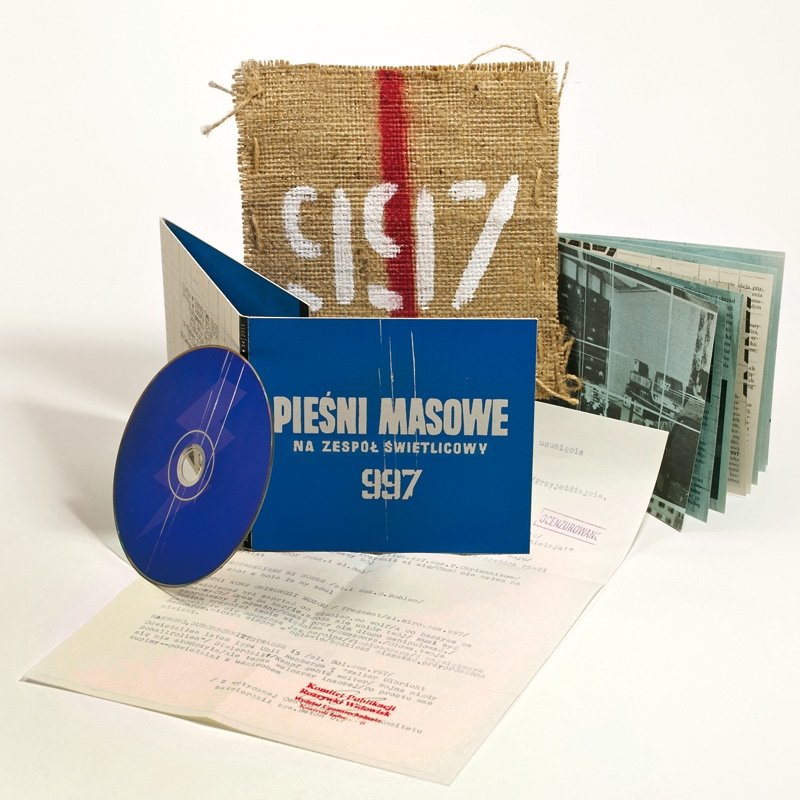If it is said that Polish industrial artists belong to the off trend, then the Warsaw group 997 represents the out trend. At the end of the 1980s, following Laibach's footsteps, it decoded the traces of the ruling system, identifying the real message of POP music with the ideological message of PrOP art. The ensemble has a special love and fascination for state-commissioned art. That is why “Pieśni masowe na zespół świetlicowy” are stretched melorecitations of oppressive Russian poetry, phantasmagoric visions drawn on the basis of a "cult" militia TV newsletter, with a smoking chimney from the East German disco in the background. Nearly a quarter of a century has passed, the 997 staff continues to create, documenting acts of mass manipulation, observing persuasion techniques in color weekly magazines, and monitoring selected national journalists without their consent or knowledge.
By posing a threat to official structures, 997 wants to become a defective cog of mass media totalitarianism, a mushy cartilage of the system, playing endlessly its maddened music.
The core of the capital group 997, which gave concerts in 1988–89, were Bolesław Błaszczyk, Dariusz Duszyński and Mirosław Jankowski. The aforementioned comrades were directly inspired by the profile of the famous editor-policeman Jan Płócienniczak and his television program, as well as art (especially music) of a social engineering nature, created on a state commission.
The team tried their hand at psychological activities, including subliminal techniques. It aspired to serve as a mirror image of manipulation and persuasion, focusing on turning them around and pointing the blade towards the starting point, i.e. to the official decision-making centers.
The band members used production instruments of the People's Democracy Countries and cellos, self-built guitars, converters, amplifiers, as well as tapes, radios, cable telephone, reciting speech, propaganda poetry and materials obtained through telephone and room wiretapping.
In public, the formation usually performed mass songs, disco music (including from the repertoire of CC Catch or Modern Talking), industrial songs (e.g. popularized by Throbbing Gristle), broadcast signals, approved by the Radio and Television Committee, presenting photos and slides colorful, strategic, black and white educational and sensational frames from a TV set, with a shocking, multi-level form and content.
The band played only a few concerts (Łańcut, Warsaw, Wodzisław Śląski), focusing on recording activities (analogue technology, the underground of the nuclear school, housing) and extra-music activities (photography, conceptual sightseeing trips, exploring historical archives, exposing the hidden connections of the apparatus of oppression with artistic aesthetics) ). Guest members of individual projects were Robert Foryś, Robert F. Herubin (known from the recently released DVD film by Grzegorz Królikiewicz “Zabicie ciotki” - "Killing auntie") and Tomasz Wolniewicz, who died in 2010. The group's mentor was musicologist and radio expert Andrzej Słodkowski.
The characteristics of the 997 ensemble include the traumatic disintegration of Poland in the 1980s, a breeze of oilcloth, chaff and concrete, and the control of shows.
The group's slogan - DISKO MACHT FREI, style - STASI KUNST, motto - ENTERTAINMENT IS OUR GREAT COLLECTIVE DUTY.
After the ban on performing under the name 997, issued in 1989, the members of the group gave their cryptoconceptual performances (including Berlin 1989 and 1995, Moscow 1996 and 1997, Śródborów). In the years 2002–2006, the team manifested openly several times (eg 997 Expo) in the Komuna Otwock office / gallery (with the participation of Ireneusz Socha) and in the Centralny Dom Qltury in Warsaw (56th anniversary of the establishment of the GDR with the participation of Robert Borowski and Steffen Moller). Archival recordings of 997 appeared on several cassettes (including by Dominik Kowalczyk's Mail Art Organization - Neurobot, Wolfram), and later on CDs.
The ranks of the basic 997 personnel today are still soldiers of the invisible front, shattered and hidden, creating, decoding, confusing clues, obliterating traces and confusing on their own as functionaries of the cultural, educational and survival sectors.
Favorites (words and music 997): Cars: barkas - wiretap car, wartburg - gas chamber, polonez - hearse, maluch - two passenger trunks (one - classic, the other on the roof), nysa - megaphone with a barbed wire unwinder. A cultivated literary form: gibberish stylized as a bad mechanical translation. Conceptual variations (words and muses 997). Mass Media are: Muss - German, Prikaz - Russian, Forced Order - Polish, Mass - English. Mass - Polish, Mass Order - Polish. "The core of the capital 997 group, touring ..." = concentrating. Konzentrationslager = Konzert Rationslager. Lager = Łagier = Schlager (pol. striking, inflicting blows) = Szlagier.
Tracklist
- Kto w Sibiri Dwa
- Kto w Sibiri Tri
- Hymnescu
- A Call
- Nielzja
- Taniec z Łopatami
- Lista osób
- Dekonstrukcja wydarzeń
- Winny Kabol
- Nothing Nobody
- Prikaz
- Katharsis
- I snowa boj

